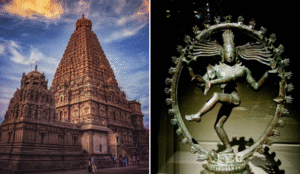
Context
-
Prime Minister of India, during the birth anniversary celebration of Rajendra Chola I at Gangaikonda Cholapuram, praised the Chola dynasty’s role in building India’s naval strength, democratic practices, and cultural unity.
-
He also announced statues of Rajendra and Rajaraja Chola and launched a commemorative coin.
Who Were the Cholas?
-
The Cholas were one of the longest-ruling dynasties in South India, active between the 9th to 13th century CE.
-
Their empire covered present-day Tamil Nadu, Andhra Pradesh, Kerala, and extended to Sri Lanka and parts of Southeast Asia.
Key Chola Rulers and Their Contributions
-
Rajaraja Chola I (985–1014 CE):
-
Strengthened naval power.
-
Built the Brihadisvara Temple at Thanjavur.
-
Expanded the empire into Sri Lanka.
-
-
Rajendra Chola I (1014–1044 CE):
-
Led expeditions to the Ganga River.
-
Built Gangaikonda Cholapuram.
-
Expanded influence to Malaysia, Indonesia, and the Maldives.
-
-
Kulottunga Chola I:
-
Focused on internal administration and revenue reforms.
-
Continued the legacy of stable governance.
-
Legacy of the Chola Dynasty
Political and Administrative Legacy
-
Kudavolai System:
-
A unique election system using palm leaf ballots to choose local leaders.
-
Example: Uthiramerur inscriptions explain the rules of local governance.
-
-
Decentralised Village Administration:
-
Local bodies like Ur, Sabha, and Nagaram managed land, taxes, and justice.
-
It was an early model of grassroots democracy.
-
-
Efficient Bureaucracy:
-
Maintained a clear hierarchy of officials — from ministers to village accountants.
-
Conducted regular land surveys and maintained revenue records (Chola inscriptions).
-
Economic and Trade Networks
-
Maritime Trade Expansion:
-
Developed strong trade links with Southeast Asia (Srivijaya), China (Song Dynasty), and Arab countries.
-
Ports like Poompuhar and Nagapattinam became important trade centres.
-
-
State-Supported Commerce:
-
The state gave charters to merchant guilds like Manigramam and Ayyavole 500 to promote overseas and internal trade.
-
-
Irrigation and Agricultural Reforms:
-
Built large tanks (like Cholagangam), canals, and embankments.
-
Helped increase food production and supported temple economies.
-
Foreign Policy and Maritime Power
-
Naval Expeditions:
-
Rajendra Chola I led sea campaigns to Sri Lanka, the Maldives, and Srivijaya (Sumatra).
-
One of the earliest examples of Indian naval strength.
-
-
Cultural Spread through Trade and Temples:
-
Chola cultural influence reached Southeast Asia — seen in temples like Angkor Wat (Cambodia) and Borobudur (Indonesia).
-
-
Diplomatic Relations:
-
Sent ambassadors to China.
-
Chinese records mention Chola envoys at the Song Dynasty court.
-
Cultural and Religious Syncretism
-
Religious Patronage:
-
Supported both Shaivism and Vaishnavism.
-
Built temples and religious institutions promoting peace and coexistence.
-
Examples: Brihadisvara (Shaiva) and Veeranarayana (Vaishnava) temples.
-
-
Temple as Socio-Cultural Centre:
-
Temples functioned as schools (ghatikas), grain stores, courts, and cultural centres.
-
-
Literary Flourishing:
-
Patronised Tamil poets and scholars like Kamban, Ottakoothar, Jayamkondar, and Sekkizhar.
-
Their works enriched both religious and non-religious Tamil literature.
-
Art and Architecture
-
Dravidian Temple Architecture:
-
Perfected the South Indian temple design — tall vimanas, pillared halls, and aligned layouts.
-
Examples: Brihadisvara Temple (Thanjavur) and Gangaikonda Cholapuram.
-
-
Bronze Sculpture Excellence:
-
Mastered the lost-wax technique for bronze idols.
-
The Chola Nataraja (Shiva’s cosmic dance) is a famous example.
-
-
Architectural Innovation:
-
Used granite, followed precise iconometric rules (Shilpa Shastra), and made intricate carvings.
-
Influenced later dynasties like the Vijayanagar Empire.
-
Decline of the Cholas
-
After the 13th century, they declined due to internal conflicts, the Pandya resurgence, and invasions by the Delhi Sultanate.
-
The remaining Chola regions eventually came under the Vijayanagara Empire.
Relevance to Modern India
-
Decentralised Governance: Their local village system is similar to today’s Panchayati Raj.
-
Naval Strategy: Recognised for early maritime dominance — inspiring India’s Blue Economy vision.
-
Cultural Diplomacy: Historical links with Southeast Asia support India’s Act East Policy.
-
Heritage Conservation: Chola temples like Brihadisvara are UNESCO World Heritage Sites.
-
National Pride: Celebrating the Chola legacy helps promote unity in diversity and cultural nationalism.
Conclusion
-
The Chola dynasty represents a golden era of strong governance, naval power, and cultural richness.
-
Their achievements in administration and art offer India a model to balance development with cultural pride.




